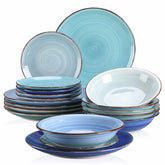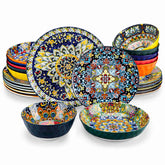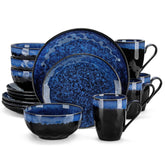What is a Spoon Rest and Why Your Kitchen Needs One?
In the whirlwind of cooking, utensils are used, put down, and picked up again and again. Whether you are stirring soup, cooking vegetables or glazing a roast, you are likely to need a place to put your spoon. Without one, your countertops can quickly be smeared with sauce, oils, and crumbs—a little mess that grows into a cleaning headache.
Here comes the spoon rest: a basic but essential kitchen accessory that most people do not realize they need until they finally acquire one. After you begin using a spoon rest, you will wonder how you ever lived without one. It not only makes your cooking process easier but also makes your kitchen cleaner and more organized.
Unpacking the Humble Spoon Rest
Essentially, a spoon rest is a shallow dish that is used to hold cooking utensils such as spoons, ladles, spatulas, or tongs while you prepare food. Usually positioned close to the stove or prep area, it has the simple function of catching drips and avoiding messes. Although it may appear to be a small kitchen gadget, its utility is far-reaching. Spoon rests come in different shapes, sizes, and materials, from ceramic and stainless steel to silicone and glass, each with its own aesthetic and practical advantages.
The design of a spoon rest is intentionally simple. Most have a slight curve or indentation that holds the handle while lifting the messy end off the counter. Others have a flat base with raised edges to contain any liquid runoff. Some even have multiple slots to accommodate more than one utensil at a time, which makes them ideal for complicated recipes that require several tools.
The Reasons Why Every Kitchen Should Have a Spoon Rest: Essential Uses and Benefits
A spoon rest may not be as glamorous as a stand mixer or as powerful as a food processor, but its importance is undeniable. The first and most obvious advantage is cleanliness. Rather than putting a spoon covered in sauce directly on your countertop, the spoon rest catches the residue. This reduces cross-contamination, particularly when cooking with raw meat or allergen-containing ingredients.
Secondly, spoon rests are useful in protecting kitchen surfaces. Regular contact with hot, oily, or acidic substances can wear down countertops. A spoon rest acts as a barrier that protects your kitchen from such wear and tear. This is an important function for those who have invested in premium countertops such as marble or wood.
Thirdly, it keeps cooking efficient. A specific place for your utensils removes the frantic search for a clean place to put them. This is particularly useful when cooking several dishes or recipes that require timing. Some spoon rests even serve as mini trays, holding other small kitchen tools or ingredients.
Finally, there is the mental advantage of order. A clean cooking area usually results in a more peaceful, pleasant cooking experience. Even something as simple as a spoon rest can make your kitchen feel more organized and intentional.
When and Where to Use Your Spoon Rest for Optimal Results
The versatility of a spoon rest also applies to where and when you use it. The most common place is right next to your stovetop where active cooking is done. This makes it within arm’s reach when you need to put down or grab a utensil quickly. However, spoon rests can also be positioned near the prep area, next to the cutting board.
A spoon rest near the mixing bowl can hold whisks and spatulas coated in batter or frosting during baking. During a buffet-style meal or barbecue, spoon rests can be placed near serving dishes to hold serving spoons or tongs. Some people even use them while preparing meals on the dining table, particularly when putting together make-your-own dishes such as tacos or sandwiches.
In essence, any place where utensils are used you can use a spoon rest. Thinking outside the stovetop, you can really maximize its utility and leave different parts of your kitchen or dining area clean.
More than Utilitarian: Spoon Rests as Kitchen Decor
Apart from functionality, spoon rests provide an overlooked chance to improve the look of your kitchen. From minimalist to whimsical, they can reflect your personality and kitchen style. Some spoon rests have quirky quotes, playful food shapes, or seasonal themes – making them not only useful but also fun.
For the elegant, ceramic or porcelain spoon rests in neutral tones or subtle patterns can harmonize perfectly with modern kitchen interiors. Rustic kitchens may be enhanced by stoneware or wooden ones, while bold or eclectic spaces can welcome brightly colored or patterned silicone models.
Another way to keep your kitchen feeling fresh is to collect seasonal spoon rests. Replacements of a floral springtime spoon rest with a festive winter one is a small detail that can add a lot of visual joy to your cooking routine. In a nutshell, spoon rests serve as mini décor pieces that add to the ambiance of your kitchen.
How to Select the Appropriate Spoon Rest for Your Kitchen: Materials and Styles
When selecting a spoon rest, form and function should be considered. The most popular materials are ceramic, stainless steel, silicone, stoneware, and glass. Each has its advantages and disadvantages.
Ceramic and porcelain spoon rests are attractive and easy to clean but they can chip if dropped. Stainless steel has a sleek, modern appearance and is very durable, but it can show smudges or water spots. Silicone is light, flexible, and usually dishwasher safe, making it perfect for high-use kitchens. Stoneware has a rustic appeal and retains heat well, while glass is elegant and stain resistant.
Size and shape also matter. Larger spoon rests can hold ladles or several utensils, which is perfect for multitaskers. Compact ones are perfect for small kitchens where space is limited. Some even have raised ridges or spouts to hold and drain liquids better.
Remember to coordinate your spoon rest with your current kitchen theme. If your kitchen is monochrome, choose a matching or complementary color. If your appliances are matte black or brushed gold, you may want a matching spoon rest to keep the visual balance.
Caring for Your Spoon Rest
Spoon rests are usually low maintenance, but a little care goes a long way in keeping them clean and new looking. Most materials are dishwasher safe but always check the manufacturer’s instructions to be sure. Hand-washing, a soft sponge and mild detergent are usually enough. Do not use abrasive pads that can scratch ceramic or stainless-steel surfaces.
For silicone spoon rests, a quick soak in warm soapy water will remove oily residue. Ceramic and stoneware models should be dried properly to avoid any water absorption that may cause cracking in the long run. If your spoon rest has stubborn stains, especially from tomato-based sauces or turmeric, a paste of baking soda and vinegar can help remove the discoloration.
Keep your spoon rest in a place where you can easily pick it up while cooking. Although many leave it on the countertop permanently, if it matches their decor, you can also store it in a nearby drawer or utensil organizer when not in use.
Conclusion
Although small in size, the spoon rest has a disproportionate role in the kitchen tool world. It’s the silent hero that makes your counters clean, your workflow efficient, and your cooking area a little more beautiful. Whether you are a professional chef or a novice learning the ropes, a spoon rest is a modest investment that pays off in convenience and cleanliness in a big way.
It is not only a functional item, but it can also be a statement piece, something that will reflect your taste and tie your kitchen decor together. There is a perfect spoon rest for every kitchen with so many styles and materials to choose from. In a world where the small things make the biggest difference, the simple spoon rest really deserves its place on the counter.













